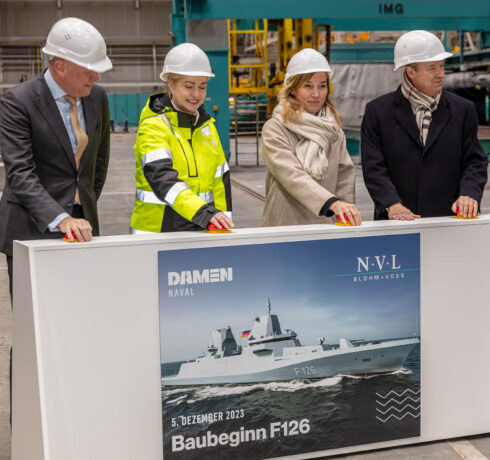The first steel has been cut, marking the official start of construction of the German F126 frigates. A festive ceremony was held at Peene Werft in Wolgast, Germany, with dignitaries from German politics, the German Navy, the media and project partners. Damen Naval Germany Director and master of ceremonies for the occasion Magiel Venema summed it up nicely when he declared, “Jetzt gehts los.”
In June 2020, the equipment organisation of the Bundeswehr, BAAINBw, awarded the construction contract for the four F126 frigates to Damen Naval, together with subcontractors Blohm+Voss and Thales Nederland. It is the largest shipbuilding project in the history of the German Navy and the contract includes an option for two more frigates.
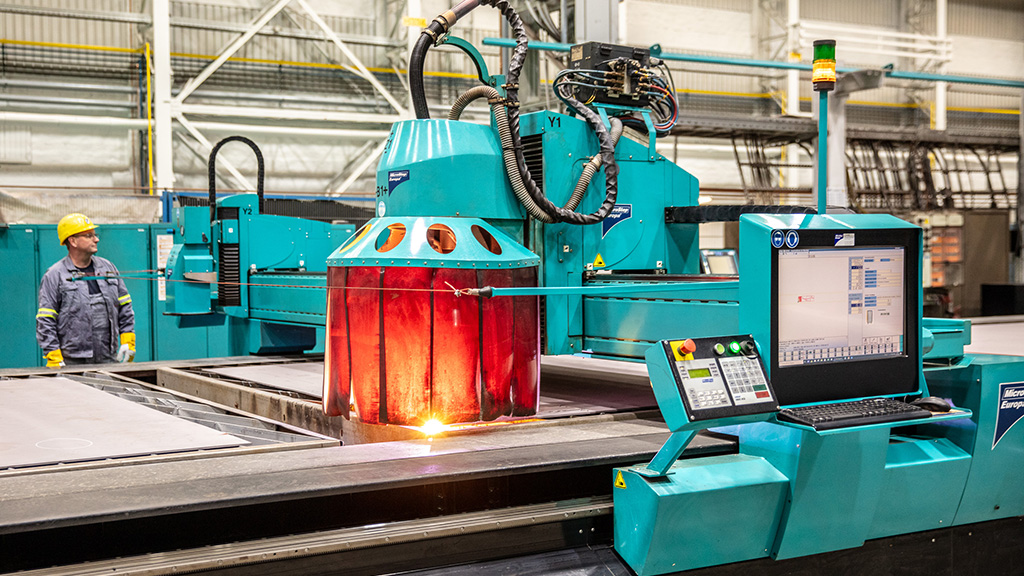 First to be cut were two steel silhouettes of an F126 frigate with inscription.
First to be cut were two steel silhouettes of an F126 frigate with inscription.
Over the past three and a half years, hard work has gone into the design for the ships, although that work has been largely invisible to the outside world, Magiel says. “The steel cutting is the first visible shipbuilding step of the project as well as the first tangible milestone taking place in Germany itself. The ships are now really starting to take shape, so everyone can see what is slowly emerging.”
Prior to the steel cutting, there was a reception with speeches by several VIPs. Host and Director of Peene Shipyard Harald Jaekel welcomed everyone. “It is special to see how so many important guests have found their way to the yard located furthest north and east in Germany. We have 75 mostly successful years of experience in building and repairing naval ships. We are proud of our history and proud to be part of the F126 team now. I can assure you that we are ready to make our contribution to the success of this project.”
“This is the moment when an idea is turned into steel and that is a very special moment.” Siemtje Möller
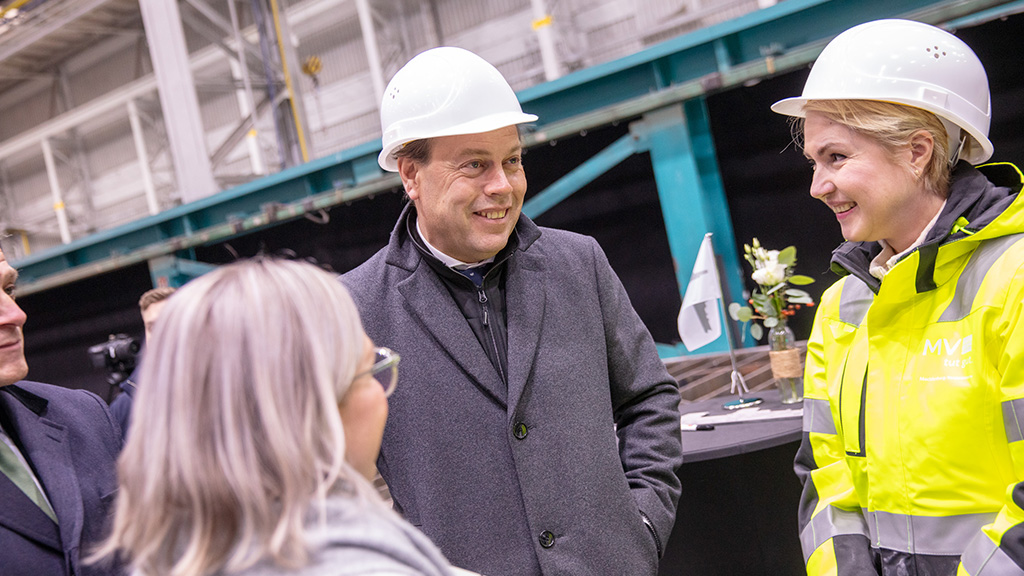 Damen Shipyards Group CEO Arnout Damen talks to Minister-President of the German state of Mecklenburg-Vorpommern, Manuela Schwesig.
Damen Shipyards Group CEO Arnout Damen talks to Minister-President of the German state of Mecklenburg-Vorpommern, Manuela Schwesig.
Damen Naval Managing Director Roland Briene began his speech by greeting the people in Vlissingen, Schiedam, Hengelo and other places who followed the ceremony via a livestream. He explained that F126 stands for innovation and cooperation and for a strong Europe. “European cooperation has never been more important than in these times of a deteriorating geopolitical situation and threats from Russia and China. Europe urgently needs to strengthen its military capabilities, especially in the naval field. The F126 frigates will play a very important role in this, as they will be equipped with state-of-the-art technology and capabilities.” He concluded with a wink: “We are going to build beautiful ships; at least four, but six would also be fine.”
The vessels will be built entirely in Germany at shipyards in Wolgast, Kiel and Hamburg. The steelwork and pre-assembly for the stern will take place at Peene Werft, part of the NVL Group. Minister-President of the German state of Mecklenburg-Vorpommern, Manuela Schwesig stressed how important the F126 project is for her entire state and the rest of Germany.
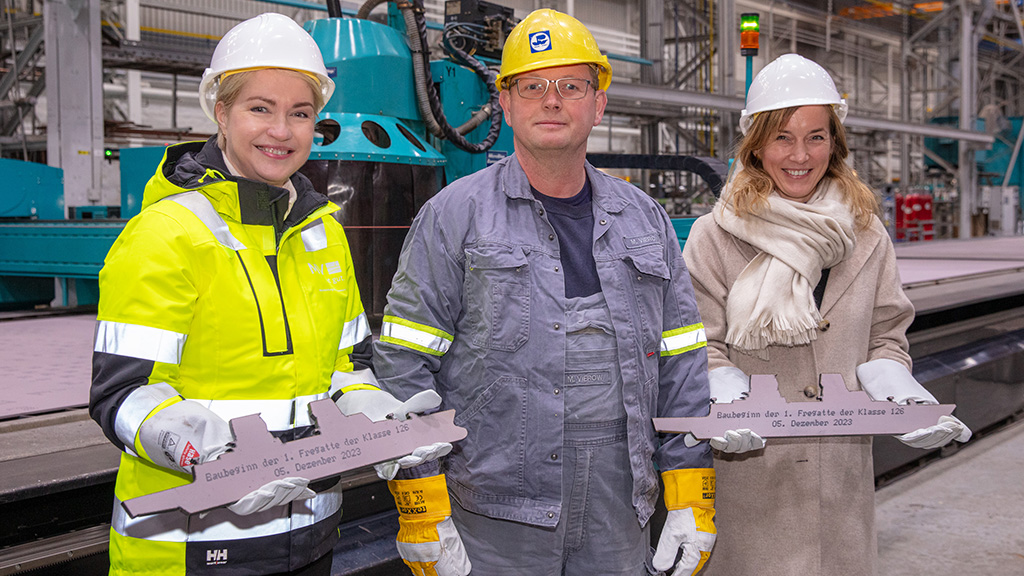 The two ship silhouettes were presented to Minister-President Manuela Schwesig (left) and Parliamentary State Secretary Siemtje Möller.
The two ship silhouettes were presented to Minister-President Manuela Schwesig (left) and Parliamentary State Secretary Siemtje Möller.
Parliamentary State Secretary at Germany’s Federal Ministry of Defence, Siemtje Möller, said that as a true coastal child, she was happy to be present at the ceremony in Wolgast. “This is the moment when an idea is turned into steel and that is a very special moment,” she said. In a more serious tone, she added: “We are taking a huge step to equip our navy with modern ships and this is a moment we can be proud of. War has returned to Europe and we are taking the threat seriously. A well-equipped armed force is no longer a ‘nice to have’ but a real ‘must-have’.”
After the final speech by Lürssen CEO Friedrich Lürssen, the guests of honour went to a production hall at the shipyard where the simultaneous pressing of four buttons started the laser cutting machine. At the buttons were Roland Briene, Manuela Schwesig, Siemtje Möller and Friedrich Lürssen. Before starting to cut the steel components for the first ship, two inscribed steel silhouettes were made and presented to the Prime Minister and the State Secretary.
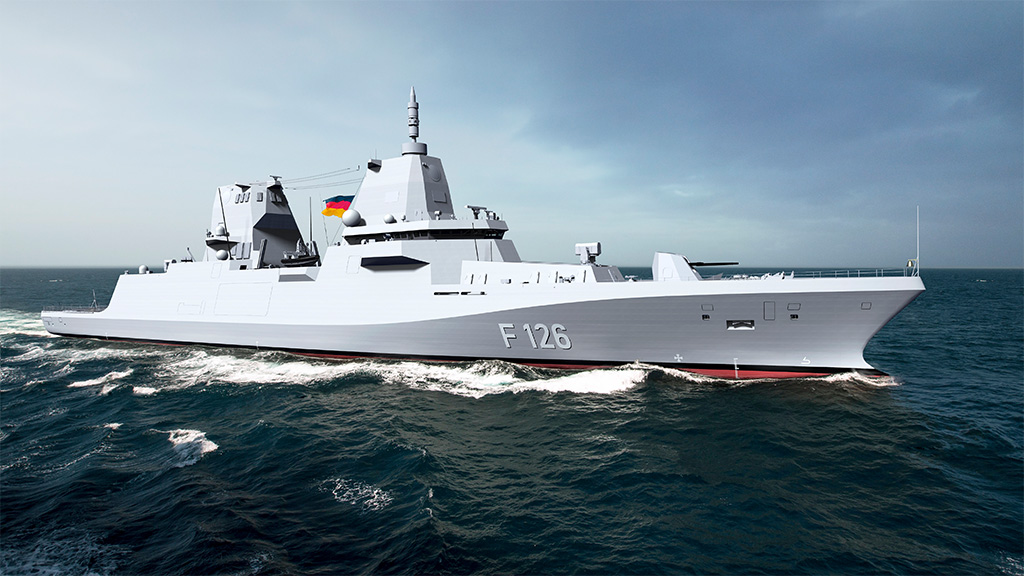 The aft ships of the F126 frigates are built in Wolgast, the forward ships in Kiel.
The aft ships of the F126 frigates are built in Wolgast, the forward ships in Kiel.

